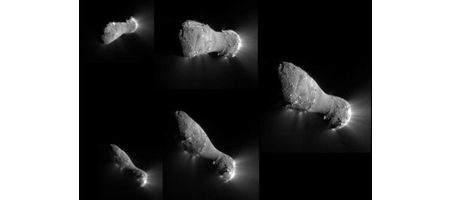Earth’s oceans could once have been giant icebergs floating through space, an ESA team has concluded, after examining the isotopic composition of a comet.

The Earth formed at such high temperatures that any original water would have evaporated. However, as we all know, two-thirds of the planet is covered in water – which must have come from somewhere.
One obvious source is comets, of which there were many more in the early days of the solar system. But until now, evidence for this has been thin on the ground.
The team examined the deuterium to hydrogen ratio foundin the oceans, and in the water of Comet Hartley 2.
The different conditions in which ice is made in space give a higher or lower chance of a deuterium atom replacing one of the two hydrogen atoms in a water molecule.
All comets previously studied have shown deuterium levels around twice that of Earth’s oceans, and therefore couldn’t have contributed more than a small percentage of Earth’s water. Indeed, astronomers had begun to think that meteorites had to be responsible, even though their water content is much lower.
Now, however, Herschel has studied comet Hartley 2 using HIFI, the most sensitive instrument so far for detecting water in space, and has shown that this one comet at least does have ocean-like water.
“Comet Hartley’s deuterium-to-hydrogen ratio is almost exactly the same as the water in Earth’s oceans,” says Paul Hartogh of the Max-Planck-Institut für Sonnensystemforschung in Germany.
The reason may be where comet Hartley 2 was born: far beyond Pluto, in the Kuiper Belt. The other comets previously studied by astronomers are all thought to have formed near to Jupiter and Saturn before being thrown out by gravity, only to return much later.
Thus the new observations suggest that perhaps Earth’s oceans came from comets after all – but only a specific family of them, born in the outer Solar System. Out there in the deep cold, the deuterium to hydrogen ratio imprinted into water ice might have been quite different from that which arose in the warmer inner Solar System.
Herschel is now looking at other comets to see whether this picture can be backed up.
“Thanks to this detection made possible by Herschel, an old, very interesting discussion will be revived and invigorated,” says Göran Pilbratt, ESA Herschel project scientist.
“It will be exciting to see where this discovery will take us.”






